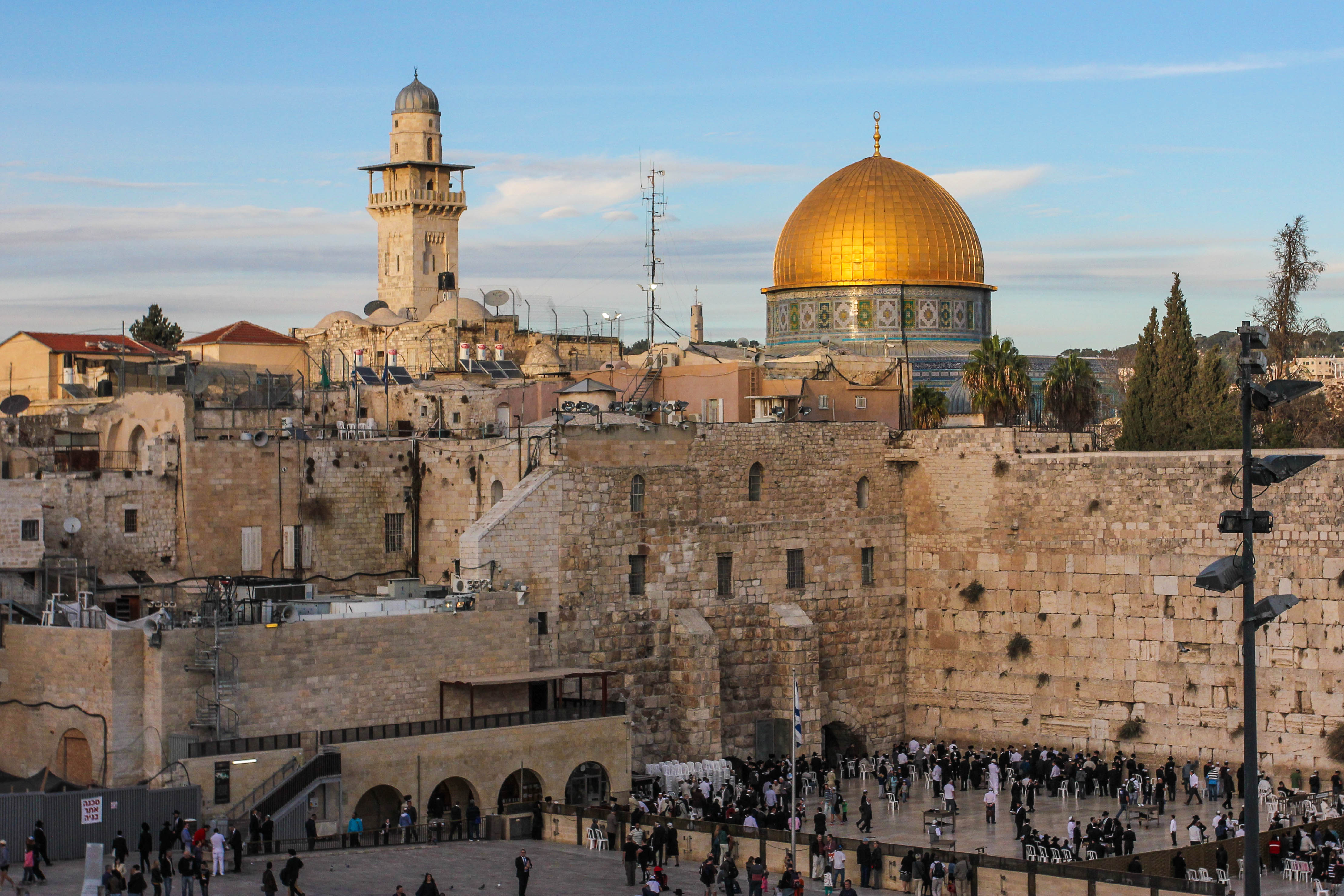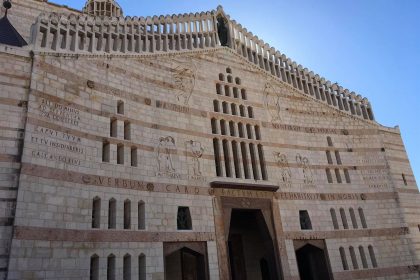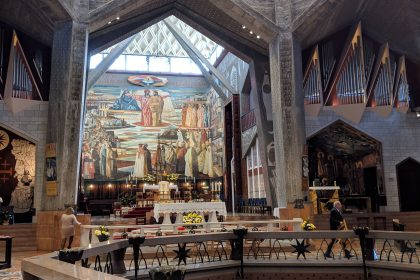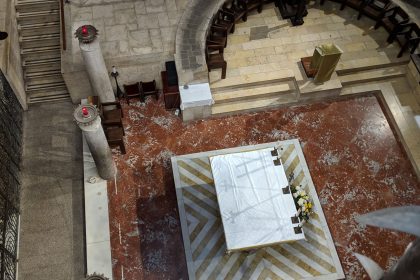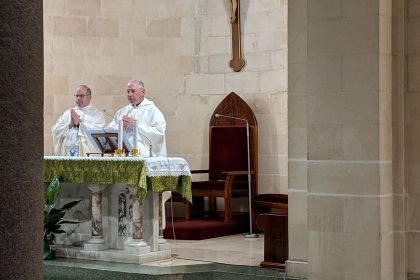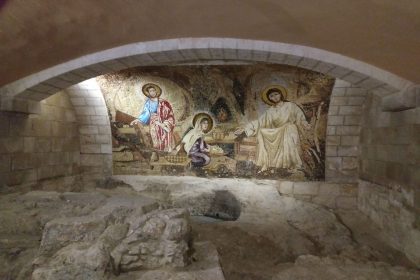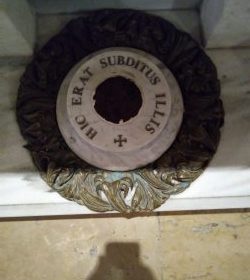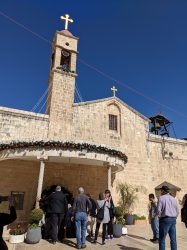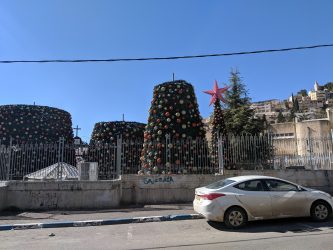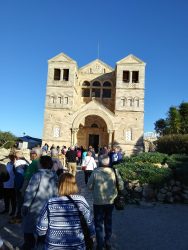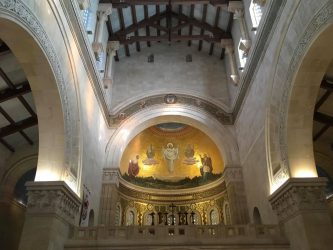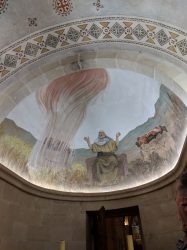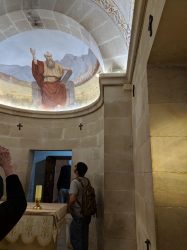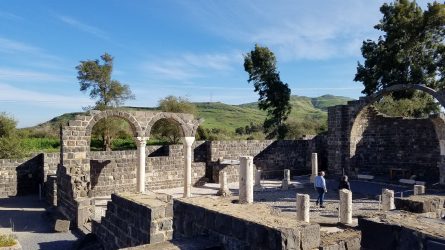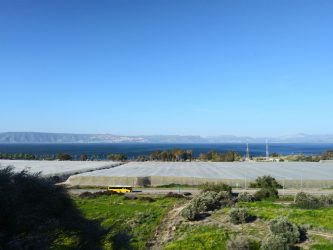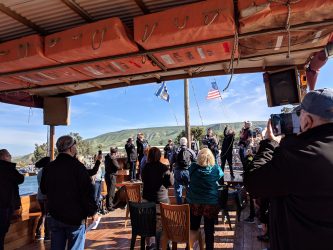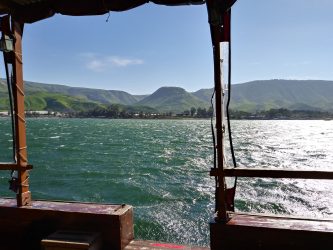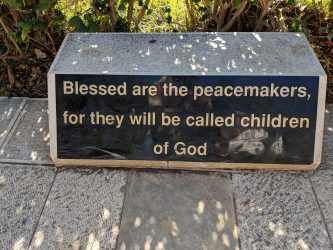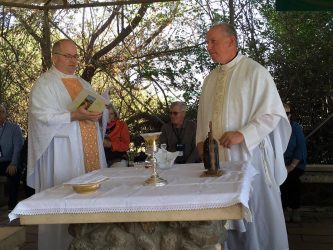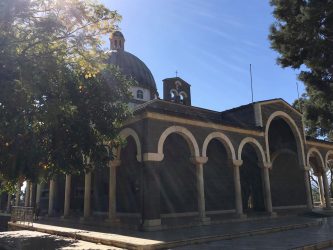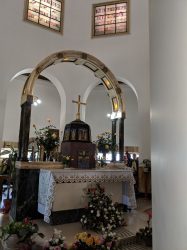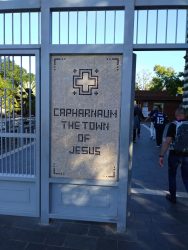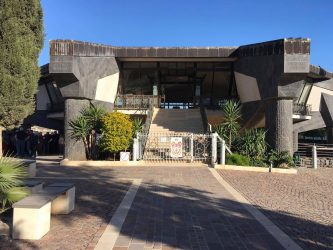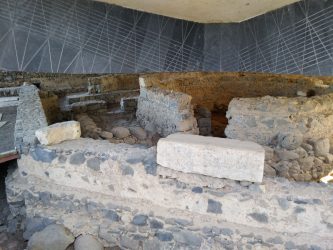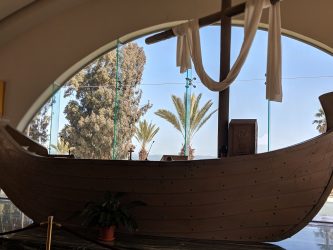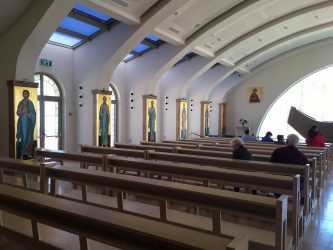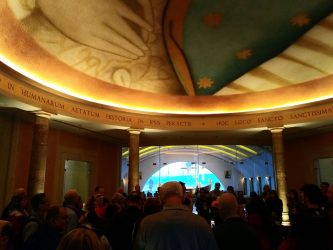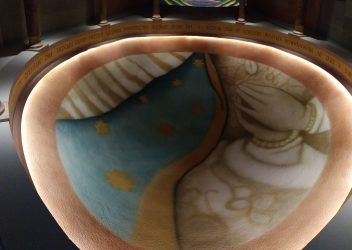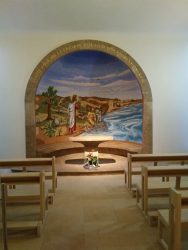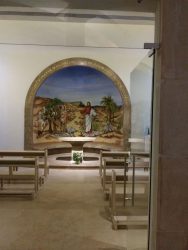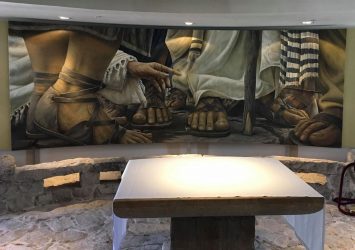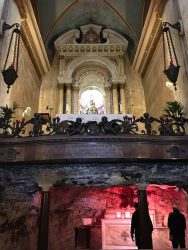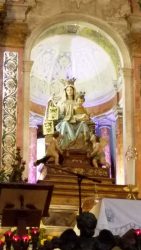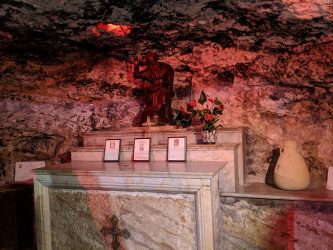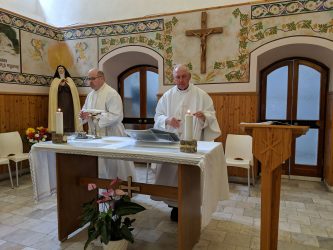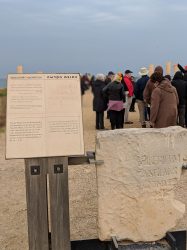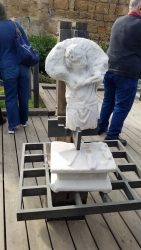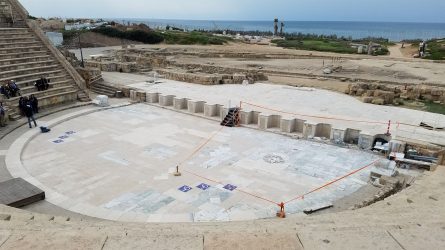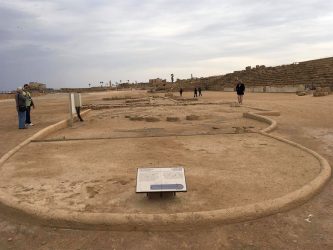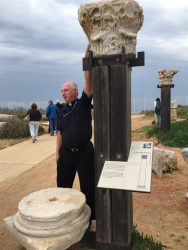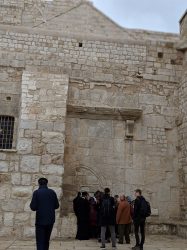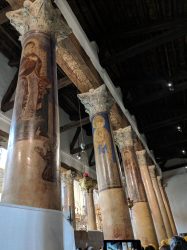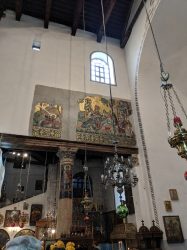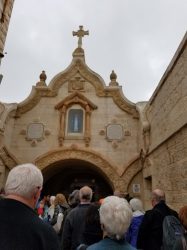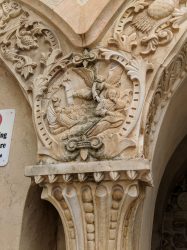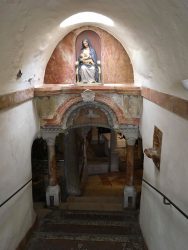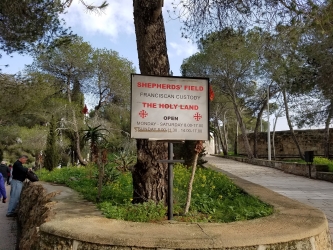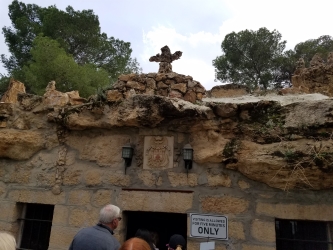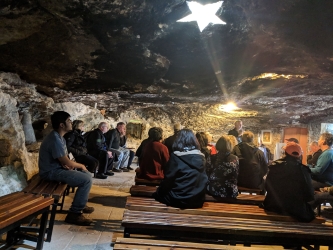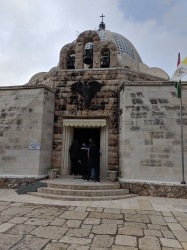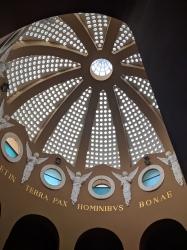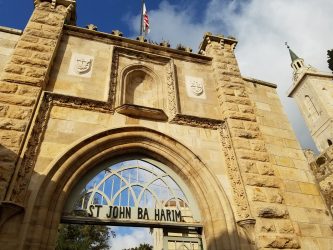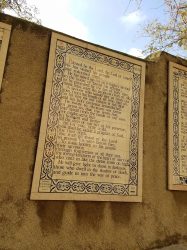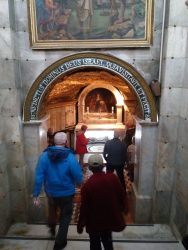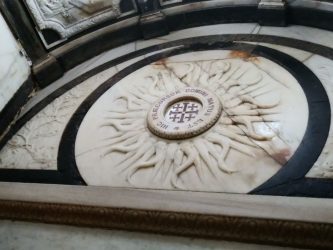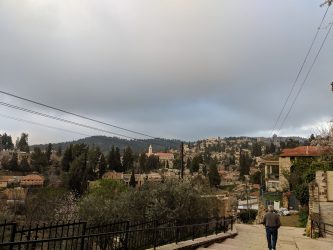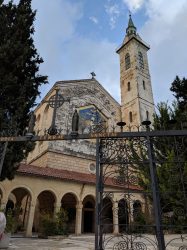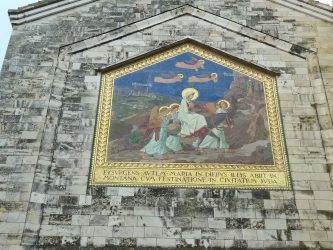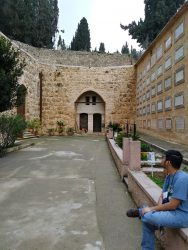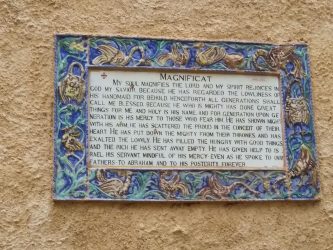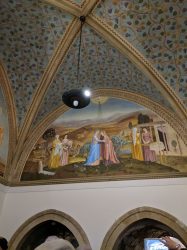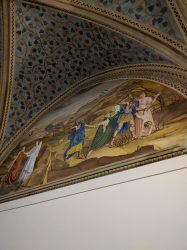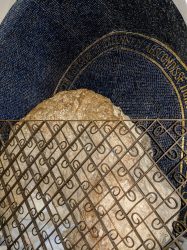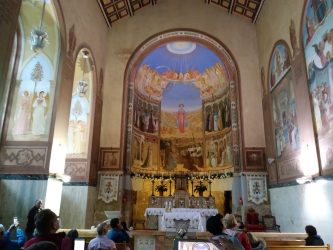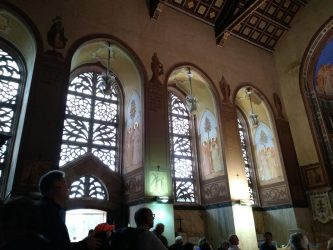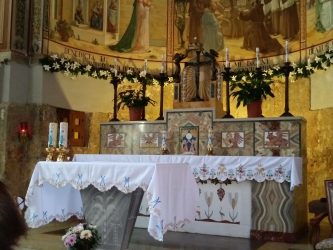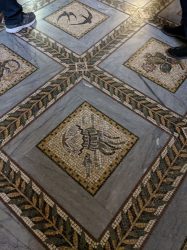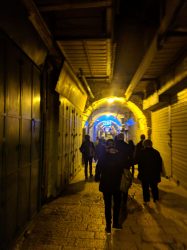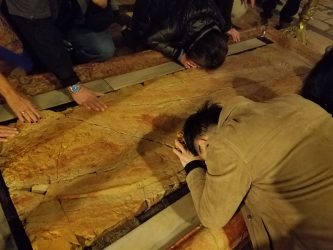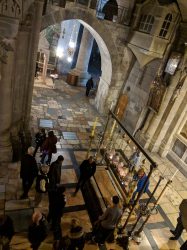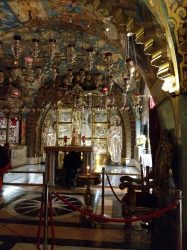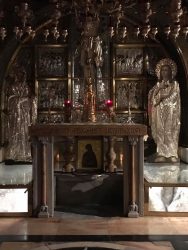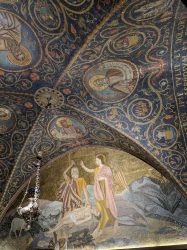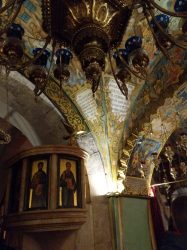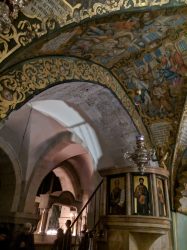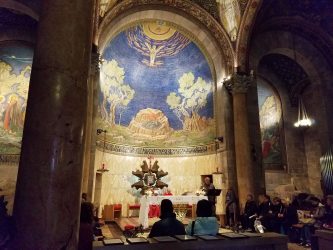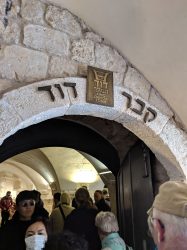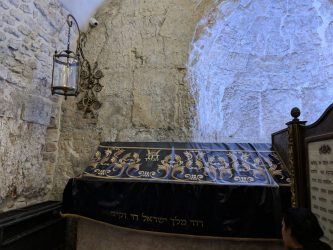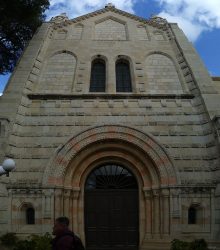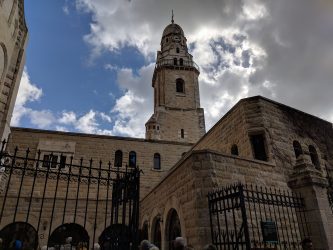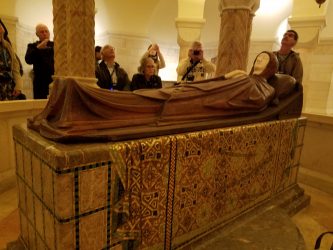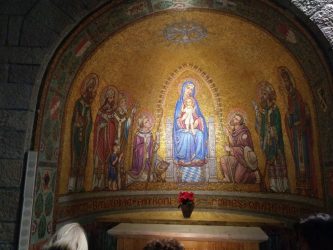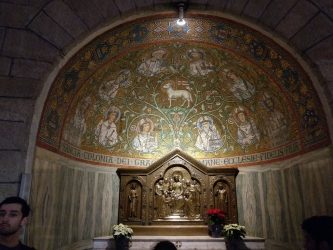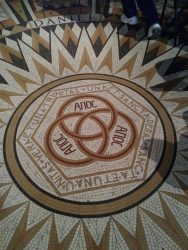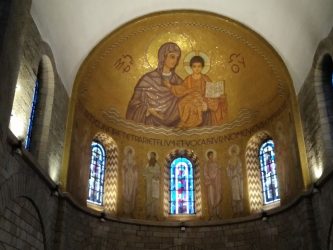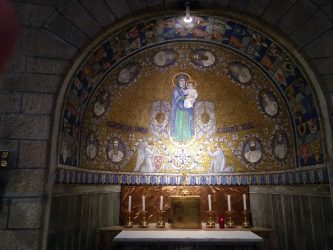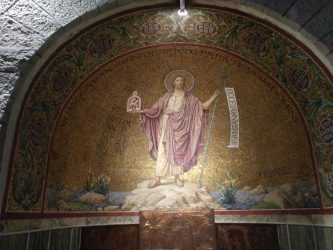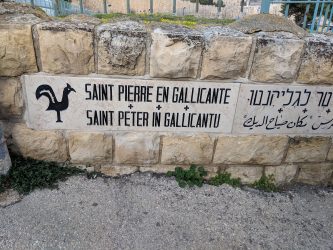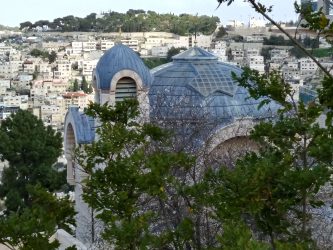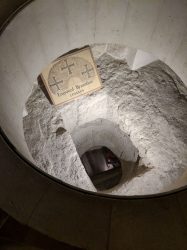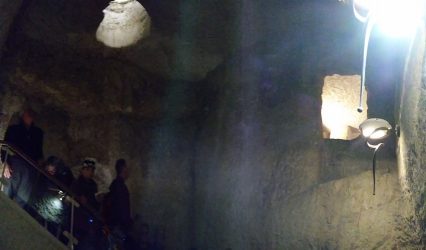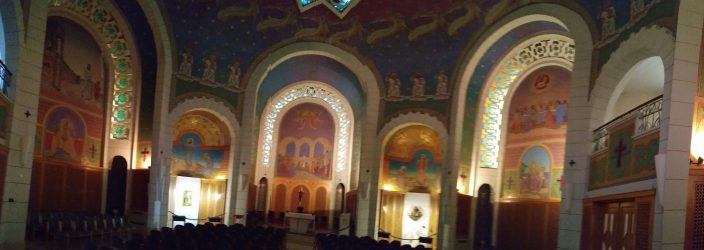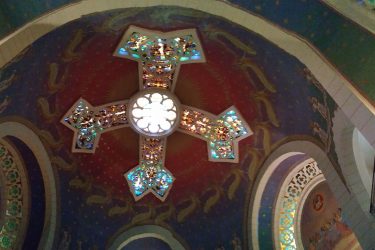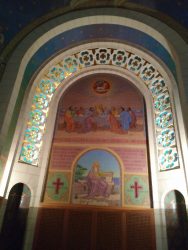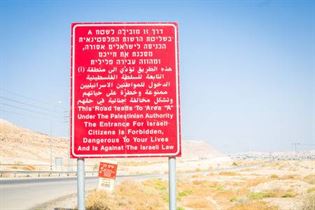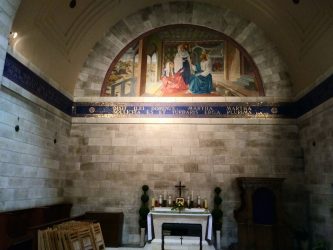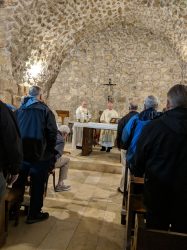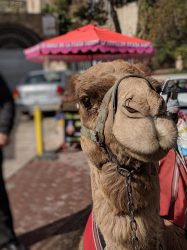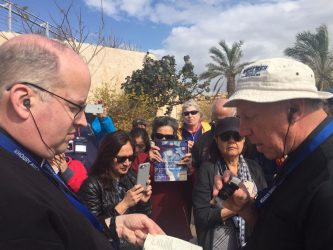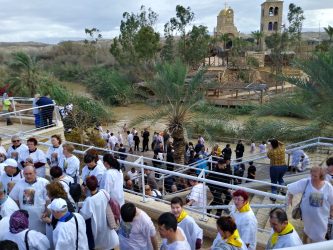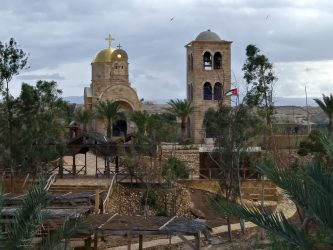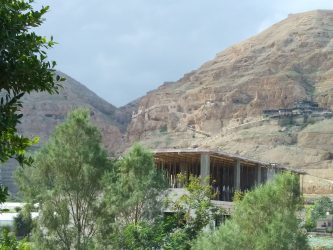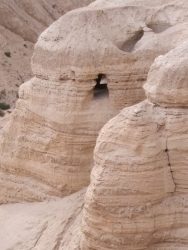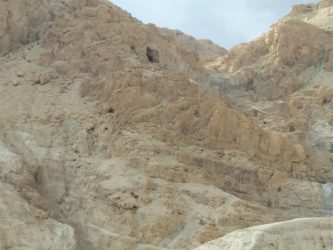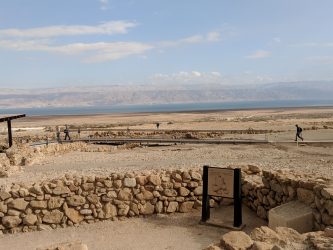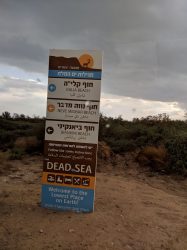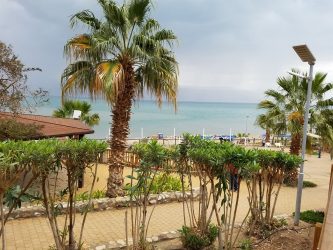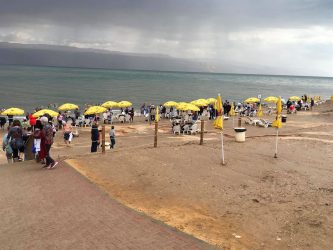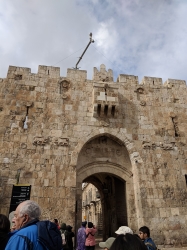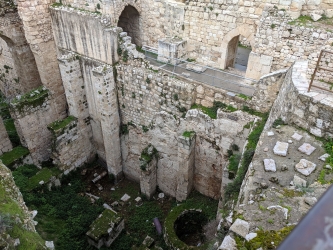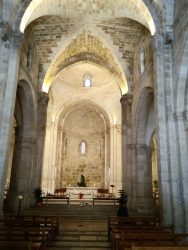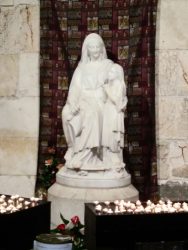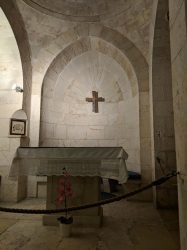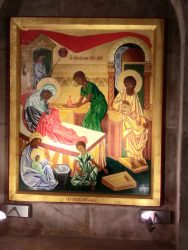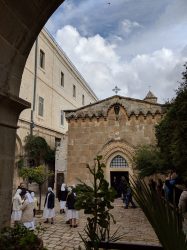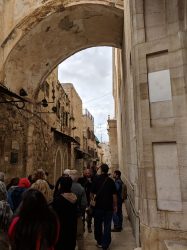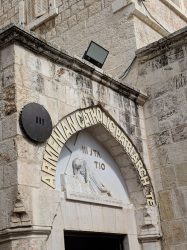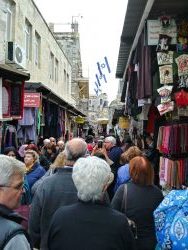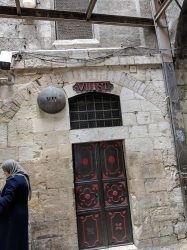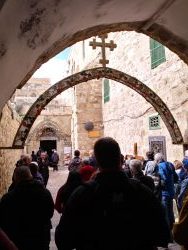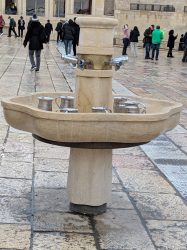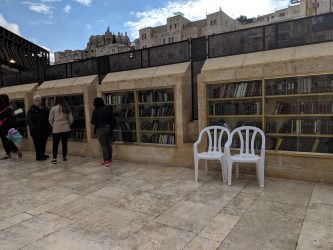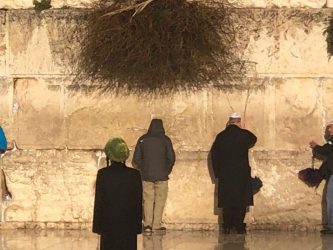In February I had the privilege of going on pilgrimage to the Holy Land for the first time with parishioners from St. Brendan the Navigator. I am indebted to my family and the parish for their generous support in enabling me to make this trip, and I am also indebted to the pilgrims who graciously provided their photos, since a few days of mine were lost while on the trip.
Day 1 (Sat. Feb. 2): Arrival in Tel Aviv and Trip to Tiberias
On February 2nd, the Feast of the Presentation, I flew from Rome to Tel Aviv, Israel to begin the pilgrimage. The majority of the other pilgrims were coming from GA, so their flight departed from Paris just before my flight departed from Rome, and we arrived within about fifteen minutes of each other. Rome was cold and rainy. As we approached Tel Aviv I got my first view of the Western coast of Israel, on the Mediterranean Sea. It looked more arid than the Italian coast, but there was still green. The buildings were clustered into complexes, square shaped, in pale sandy colors.
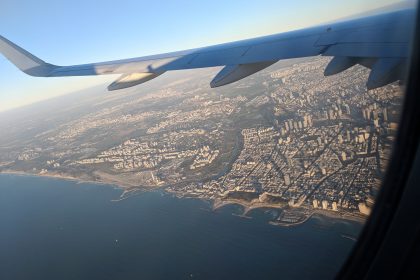
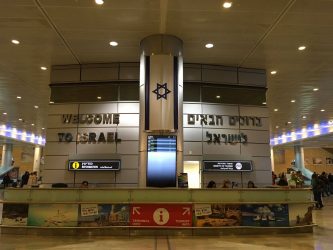
This was the farthest East I had ever been. My travels were to the United States, Canada a few times, Mexico once, and parts of Europe. As I met the main group and we boarded the bus the sun had set, so as we went northeast to where we’d be lodging, Tiberias, I couldn’t take in much scenery. What struck me was this was the first time in a long time I had visited a country where I could not understand the language at all: the signs were in Hebrew, some also in Arabic, and if you opened Google Maps many of the places appeared in Hebrew too. It was the first time I’d seen the parishioners in about four and half months, since I had been teaching in Rome since September, so it was a happy reunion. There were also two pilgrims from my home town of Watsonville, one of whom had been my classmate at Moreland Notre Dame School.
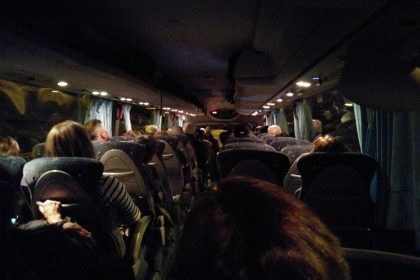
As we drew nearer to our lodgings in Tiberias I was struck by how similar the neighborhoods were organized like Europe (at least Italy and Croatia): larger apartment buildings, and lots of little stores. Our guide explained that we had avoided the usual rush hour traffic because the Jews were in the Sabbath rest from sundown on Friday to sundown on Saturday. They were only just coming out to shop after having been gathered in homes or hotels with their families. The next day that I would see them walking around, some with the kippah (little skullcaps), some with the black suit and black brimmed hat characteristic of Rabbis. Sunday for them was the first day of the work week, just as Monday is for us in the U.S.
I was somewhat awestruck as I arrived in the Holy Land. It was similar to when I saw Pope John Paul II in person for the first time in 1999, or visited the Shrine of Our Lady of Fatima about a year and a half ago. I was visiting what some describe as the “Fifth Gospel”: where Jesus became flesh, was born, grew up, did his public ministry, suffered, died, rose, and ascended into Heaven. I was visiting places mentioned by name in the Old and New Testaments. The Saturday before my departure for the Holy Land we had our monthly retreat in Rome and I went over the itinerary spiritually and prepared notes so that each day I could begin by spiritually meditating the places I was going to see and the events I was going to recall. These stories had reached me as I was raised in California, and now I was going to where these stories actually happened.
On this first night the main chaplain for the pilgrimage, the pastor of St. Brendan’s, described what our stories were going to be like: stones thrown into water, leaving ripples in their wake. Our stories would ripple out among our families and friends. With today’s technology we have so many ways to communicate instantly. Imagine for a moment how the Word of God reached you. Person to person, generation to generation, going where they traveled. The first decades of Christianity had only the Old Testament in writing (which also began as oral tradition); the rest was witnesses and testimonies.
We maintain contact, but I would argue that we rarely achieve that same level of witness, or even communication, that we did before. That’s one of the reasons why I prefer to blog. Social media gets more visual, but also more terse. They say a picture is worth a thousand words, but it still pales to telling a story, which requires attention, interest, and, to a certain degree, commitment on the part of the listener. If it’s a “good” story (engaging and interesting) it gets shared. The Holy Land helps us remember the greatest story ever told: that of Jesus, the Word of God, a story which has affected us all.
Day 2 (Sun. Feb. 3): Nazareth, Cana, and Mt. Tabor
The lodging I had in Tiberias had a wonderful view of the Sea of Galilee, also known as Lake Tiberias. We were up north in the area where Jesus was born, and today we were going to his home town, Nazareth. Even the second day of the pilgrimage, as I watched the dawn and sunrise on the Sea of Galilee I was in awe, wonder, and gratitude for having had the opportunity to come on pilgrimage here. I like to do my due diligence, so before I left Rome I went through our itinerary, looked at spots on maps, and got a general idea of what we were going to see each day. A few minutes before we got onto our tour bus a pilgrim in my group pointed to the body of water and asked me what it was. I told her (“The Sea of Galilee. Really? Really.”) and her jaw dropped, and she all but ran to get closer to the shoreline for a picture.
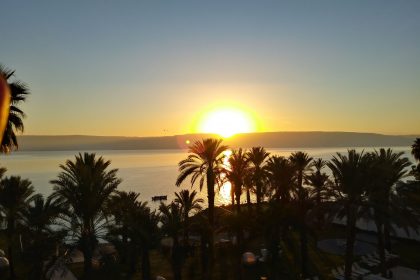
As I was meditating that morning it occurred to me that during this pilgrimage we would be doing geographically what we normally did chronologically: during the liturgical year we commemorate the mysteries of Christ’s life that occurred in what we call salvation history. In the Holy Land, if you visit a place where an event happened, you can celebrate the liturgy for that event instead of the liturgy scheduled on the general liturgical calendar for that day. Case in point: the Annunciation. On this day we visited the Church of the Annunciation in Nazareth that was believed to have been built on Mary’s home when the angel Gabriel invited her to become the mother of God (see Luke 1:26–38). So we used the liturgical prayers for the Solemnity of the Annunciation, usually celebrated on March 25th.
We contemplated Jesus’ hidden life in two ways on this day:
- His private life. We were in his home town, where he grew up, and spent years living with the rest of the Holy Family before beginning his public ministry. The streets we walked were built on the neighborhoods where he played, visited family and friends, etc. It was also a place of the hidden life of Mary, who treasured things in her heart, and of Joseph, who quietly worked as a just man and provided for Mary and Jesus. It teaches us that even a hidden life can be a holy life, a lesson many contemplative nuns and monks live even today, but not just them; every believer is called to simply do their part in the family and strive for holiness without a lot of fanfare.
- His divine life. There was also another hidden life to be revealed: his divinity, which we contemplated later in the day by visiting Mt. Tabor, where the Transfiguration took place.
In the Church of St. Joseph, in the same complex as the Annunciation, we celebrated the Mass of Annunciation, and in the opening prayer and Gospel the Missal made a point of adding the word “here” to underscore that the event we were celebrating took place in this town. After Mass we went down below the main church to see the spot where Joseph’s workshop was believed to be, the reason why this church was built on this spot. At the base of an altar a Latin inscription read hic erat subditus illis (here he was obedient to them), referring to Jesus being obedient to Mary and Joseph (see Luke 2:51).
We returned to the Basilica of the Annunciation after Mass to visit the first floor. Below was an altar that said: Verbum caro hic factus est (Here the word became flesh), the spot where Gabriel invited Mary to become the Mother of God, she accepted, and the Word became flesh, touching humanity in a way that would transform it for the better forever. I choked up contemplating here the human life that Our Lord took up here alongside his divine life and never relinquished.
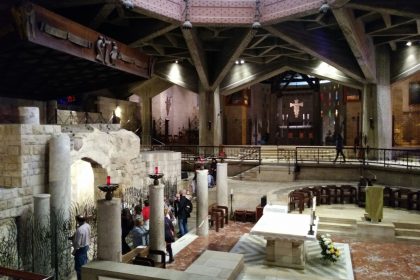
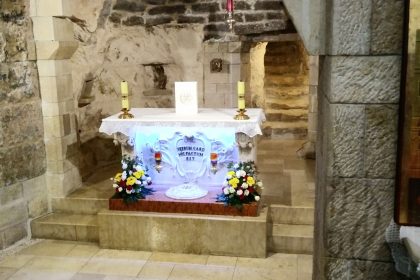
After the Basilica we visited the spot, adjacent to a Melkite (Greek Catholic) parish where the synagogue of Nazareth was believed to have stood. Our Lord had attended Sabbath services there, and it was probably also the place where after revealing he was the Messiah he told his former neighbors and friends that they shouldn’t expect much wonder-working and they almost threw him off a cliff (see Luke 4:16-30). Our guide Ghassan (who went by Gus during our visit) pointed out that this was probably why Capernaum became his new base of operations, a place we’d visit later in the pilgrimage.
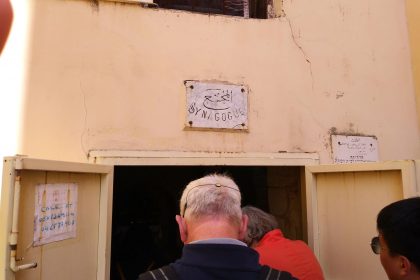
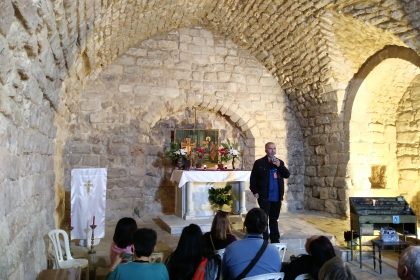
At the Church of St. Gabriel (run by the Greek Orthodox) we visited the well where Mary probably came often with Jesus to fetch water. Inside the church there is a place where you can still hear the water running.
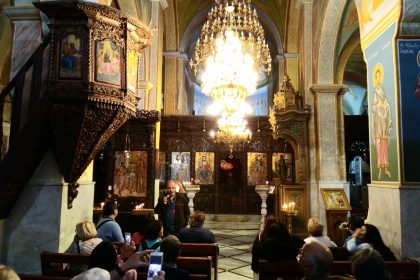
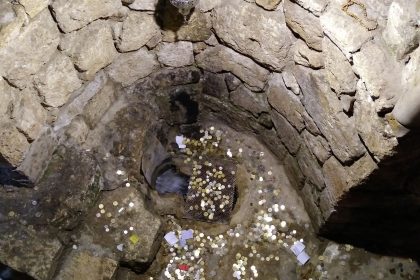
The plaza outside this church still had Christmas decorations up (the tree in the photo below is in four pieces: it stands fifty feet tall). Catholics celebrate Christmas starting on 12/24, the Orthodox celebrate on 1/6 (when Roman Catholics celebrate the Epiphany) and the Armenian Orthodox celebrate it on 1/18 (in the Holy Land the Orthodox use a different calendar which is twelve days later, therefore they celebrate it on 1/18 instead of 1/6). The Christians in the Holy Land made an extra effort this year to place Christmas decorations in public places and show their presence. Currently Christians represent 2% of the population of Israel (
source) according to an article published at Christmas. In the occupied Palestinian territories they make up 1.25% of the population (
source). In and around Bethlehem Christians were 86% of the population, and by 2016 dropped 12%. “Across the West Bank, Christians now account for less than 2 percent of the population, though
in the 1970s, Christians were 5 percent of the population” (
source). They are suffering a lot to give witness in the lands where Jesus lived and walked and deserve our support and prayers.
Being in the Holy Land was an ecumenical (inter-Christian) experience. Not only were the holy sites under the stewardship of Catholics and Orthodox, but pilgrims of various Christian confessions come as well. In the restaurant where we lunched there was an Anglican group, and later this day we visited a site along with some Romanian Orthodox, who stopped at spots and sang prayers.
In the afternoon we traveled to Cana, the spot where the first sign chronicled in John’s Gospel took place (see John 2:1-11). On the facade of the Church, at the top, the statue of Mary was highest, showing her intercession done on the newlyweds behalf when their wine was running out. In a beautiful chapel flanking a gardened courtyard our married pilgrims renewed their wedding vows. One couple had been married for 56 years. Cana was also the town where the second sign chronicled by John’s Gospel took place: a centurion asked Jesus to heal his servant in Capernaum and Our Lord did so without having to see him (John 4:46).
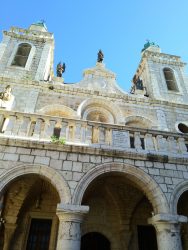
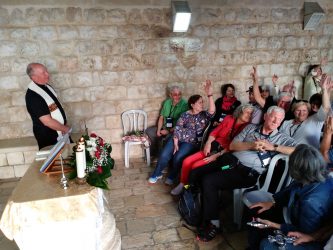
The day concluded with a visit to Mt. Tabor, where it was believed the Transfiguration took place, another moment of Jesus’ hidden divine being revealed to strengthen his closest disciples for the trials that were to come (see Mark 9:2-13, Matthew 17:1-12, and Luke 9:28-36). The Church built there had two towers in the facade with a small chapel in each, one for Moses, one for Elijah, recalling how Peter had offered to construct booths for them and Our Lord. In the Church’s design Our Lord is present still in the middle as the Blessed Sacrament.
Day 3 (Mon. Feb. 4): Our Lord’s Public Ministry
The third day of our pilgrimage was dedicated to visiting various sites around the Sea of Galilee where Our Lord did his public ministry. We began by visiting the small park of Kursi, where the ruins of a Byzantine chapel and monastery had been unearthed commemorating the spot where Jesus had encountered the man afflicted by the demon(s) who identified themselves as Legion who asked the Lord to let them pass into a herd of swine that rushed into the water and drowned (see Mark 5:1–20, Matthew 8:28–34, and Luke 8:26–39). A small hermit chapel above the site gave a wonderful view of the Sea of Galilee. We were blessed with a clear day, but windy. We spent a half-hour or so sailing on the Sea of Galilee, with breathtaking views all around. Being a flat boat it was surprising stable, despite the whitecaps all round us, and covered, cutting down on the wind. The uncovered bow, on the other hand, was another matter. The wind blew very strong there and could have easily blown somebody careless overboard. At least one hat was lost in the expedition.
In the late morning we made our way to the Mountain where Jesus taught the Beatitudes. I and my brother priest took turns presiding over Mass and preaching the homily. It was my turn. Theologically the pilgrimage had already been mind-blowing, so I started by sharing with them a couple of the reflections I’ve already shared in this blog, and added the example, taken from St. Augustine, that the sour note of sin in the “symphony” of history had been brought into harmony again by the corrective note of Jesus’ Incarnation. That corrective note sounded sour to the people used to listening to a symphony distorted by sin. Each Beatitude begins “Blessed are they who…for they…” If you take those marks of being blessed the world would consider you crazy (poor of spirit, meek, mourning, etc.). Saint John Paul II in his encyclical Veritatis Splendor taught that the Beatitudes are attitudes spurred on by promises (see n. 16). When the Church beatifies someone she declares that they lived these beatitudes in their earthly life and now experience those promises fulfilled in Heaven. That beatific life starts here in our earthly life: the Beatitudes shape our attitudes and we place our theological hope in the promises Our Lord made for those who life them (the Kingdom of Heaven, to be called children of God, to be consoled, etc.) and that leads to a beatific life here and now that people notice, leading them closer to Our Lord.
After lunch we went to Tabgha, the spot where Our Lord multiplied the loaves and fishes (see Mark 6:32-43, Matthew 14:13-20, and Luke 9:10-17). Inside the relatively new Church there is the rock on which it was believed Our Lord blessed the food and started handing it out. Given how many people were fed it’s not a stretch to say we all walked where those people had sat to eat. The Church also had a beautiful mosaic at the foot of the altar depicting four loaves and two fishes. Why only four loaves? Because Jesus, the Bread of Life, was the fifth loaf, an allusion to the miracle of the multiplication and discourse on the Eucharist found in John 6.
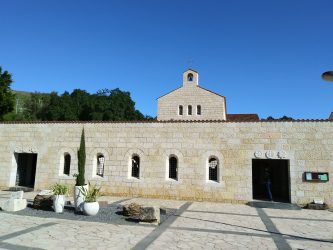

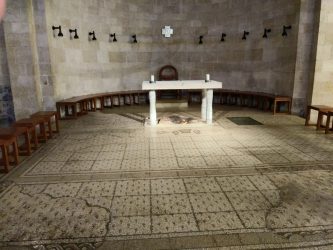
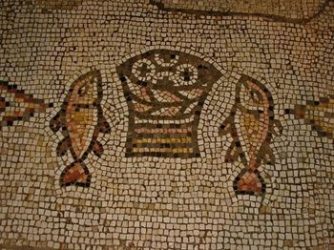
Not far from Tabgha by bus was the Church of the Primacy of Peter. Since it referred to Peter’s Primacy (the foundation for the ministry of the Pope as the successor of Peter, who has a jurisdiction over the entire Church spread throughout the world, as opposed to just one diocese, like other bishops–see Vatican I, constitution Pastor Aeternus) I expected it to be the spot where Jesus asked the disciples “Who do the people say that I am?” and Peter responded that he was the Christ, prompting Our Lord to say Peter would received the keys (see Matthew 16:16-18).
As the guide explained the spot I realized that this was actually the spot where the Risen Lord, recalled in John’s Gospel (chapter 21), had prepared breakfast for the disciples who’d fished all night, and then walked along the shore of the Sea of Galilee entrusted his flock to Peter as he asked him three times, “Do you love me?” The passage of Peter and Jesus walking on the shore (John 21:John 21:15-23) was one of my favorites, and now I could walk the same shore they did and renew my love for Our Lord and my promise to help tend his sheep as a priest. Inside the Church was part of the rock where Our Lord prepared breakfast.
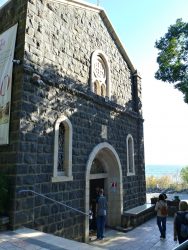
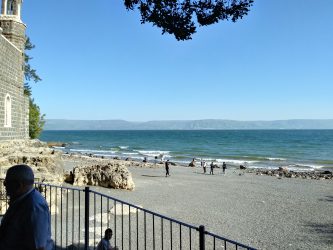
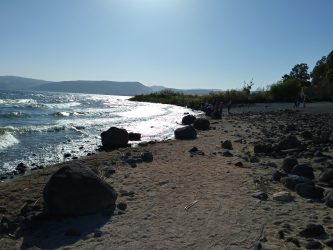
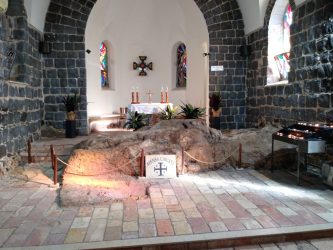
To conclude the day we went to Capernaum, Our Lord’s home away from home. Ten miracles are chronicled there. It was way point and tax collection station for those travelling to and from Mesopotamia, and Matthew probably worked that station. Five apostles lived there: Peter, Andrew, James, John and Matthew. There is a raised church built over Peter’s house, and the ruins of his house can been seen from glass floor in the church or below the structure. Not far from the Church is the synagogue and other parts of the town. The Church was closed while a Mass was being celebrated, so after explaining the area our guide took us to the synagogue and told us a little about its layout before giving us time to look around and take pictures.
About fifteen minutes before the conclusion of our visit they opened the church and an army of people invaded to take pictures and look around. After taking a few pictures I spent a moment in silence (interior, anyway–people were buzzing around) before the Blessed Sacrament in a tabernacle in the form of a Franciscan Tau cross. While sitting there I received either an inspiration or a realization (the Holy Spirit can hide his tracks very well): the synagogue I had been sitting in was where Our Lord taught about the Eucharist for the first time (see John 6:17, 24, and 59). I went back to the synagogue and let myself be overwhelmed for a few minutes.
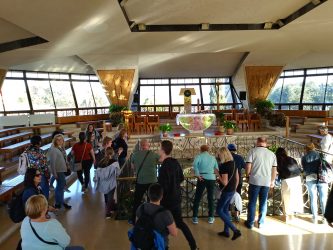
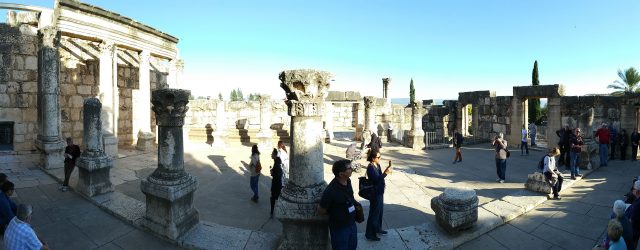
Day 4 (Tues. Feb. 5): Caesarea Philippi, Magdala
Each morning in Tiberias I had a wonderful view of the sun rising on the Sea of Galilee as I did my morning prayers and prepared myself spiritually for the day. A couple of days were windy, with the palm trees swaying and an anchored boat in the water rotating around its anchor line. It struck me that the wind diminished considerably when the sun came up. I’m sure there was some meteorological explanation, but spiritually it reminded me how the light of Christ, which we remember especially during the Easter Vigil and Baptism, is a glorious dawn that brings calm after the turbulent ages of sin and death. We can only imagine on this earth the sudden quiet of death blooming into eternal life, calm, quiet, and suddenly brilliant, like daybreak.
We headed north to the Hermon Stream (Banias) Nature Reserve, still in Israel but bordering on Lebanon and near Mt. Hermon. As we headed to the Reserve the guide pointed out where the Lebanon border was within view. There were also spots fenced off with warning signs about a mine field separating both countries’ borders. This nature reserve was where Caesarea Philippi was located (we would later visit another Caesarea on the coast, Caesarea Maritima) and also one of the springs feeding the Jordan River. The Gospel tells us that this is the area where Jesus asked his disciples who they thought he was, and when Peter professed his faith in Jesus being the Christ Our Lord entrusted him the keys to bind and loose on Heaven and Earth (see Matthew 16).
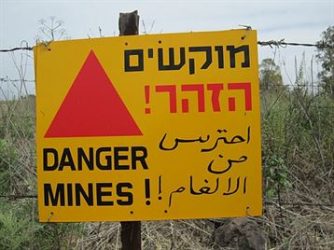
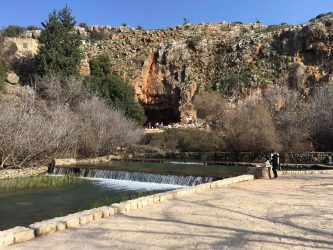
The area is called Banias, from Arabic, but that is actually a corruption of the original Greek word, Panias, which referred to the fact that a temple dedicated to the Greek god Pan was built on this site, along with some other pagan temples. The pagan temple had a grisly tradition: in a large cave there was a large hole over the river that ran below it. They would sacrifice a goat to Pan by throwing it in the hole. If the dead goat did not resurface downstream it was believed that Pan had accepted the offering. If it did resurface, Pan was displeased with the offering and a child had to be thrown into the hole as atonement. A graveyard had been found containing the bones of the goats that had resurfaced.
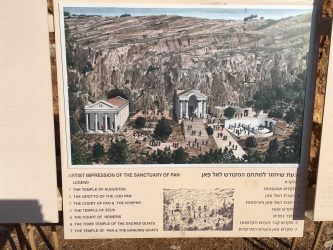
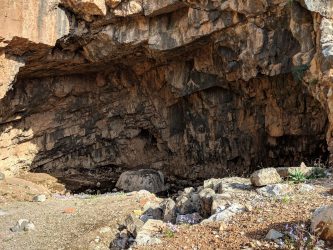
When Our Lord told Peter that the gates of Hell would not prevail against the Church (Matthew 16:18) it’s very likely his disciples had the foreboding cave of sacrifice used by the worshipers of Pan in mind. Caesarea Philippi was an opulent center of pagan power, but eleven of those disciples would go on to evangelize the four corners of the known world and bring them the Gospel. Those opulent temples today are ruins that were buried for centuries before archaeologists dug them up.
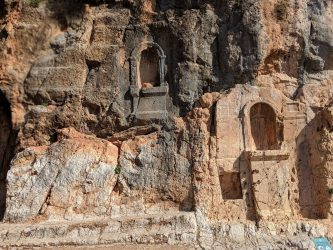
After visiting the Nature Reserve we returned south and visited a little piece of home for Regnum Christi members and Legionaries of Christ: Magdala, associated with the Notre Dame of Jerusalem Center where we’d be staying in Jerusalem, but founded and developed by the Legionaries of Christ and Regnum Christi. Magdala is Mary Magdalene’s home village, and archaeological digs on the site uncovered the ruins of a synagogue from the I century A.D., along with part of the original town, including a place for processing fish.
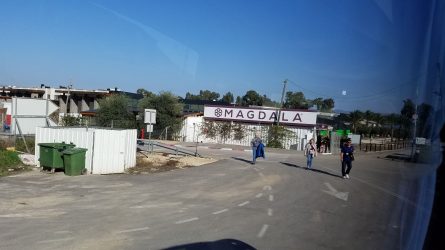
In the ruins of the synagogue they discovered what is now called the Magdala stone, the oldest extant depiction of a menorah (the seven-candle candelabra). The Israelis consider it the greatest archaeological find of the last half a century. I should mention that when the Legion acquired the land we had no idea what we’d find; our only intention was to build a quiet retreat center near the Sea of Galilee. The property is currently being developed to welcome Christian and Jewish visitors, including lodging to be completed in the summer.
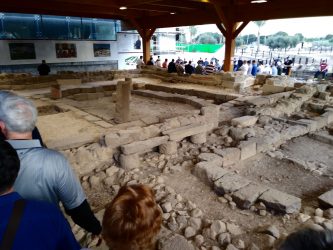
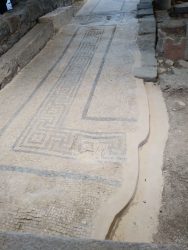
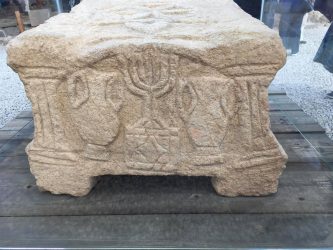
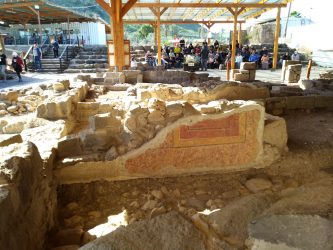
One part already completed is the Duc in Altum chapel (Latin for “put out into the deep, referring to Luke 5:4), where we celebrated Mass. The main chapel has an altar in the shape of a boat, and other chapels have mosaics of women from salvation history, such as the Hemorrhagic woman and the little girl Our Lord raised from the dead, as well as Peter’s call and attempt to walk on water. In the center of the building is a circular area with a holy water fount in the center surrounded with columns bearing the names of Biblical woman, and the inside ceiling has a beautiful design inspired by the image of Our Lady of Guadalupe.
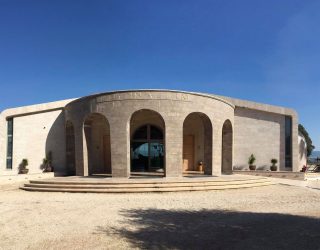
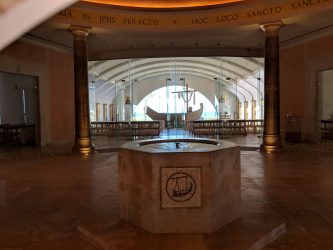
Day 5 (Wed. Feb. 6): Mt. Carmel, Caesarea Maritima, Jerusalem
On the fifth day of our pilgrimage we started making our way down to Jerusalem using the coastal road. In the late morning we arrived at the town of Haifa, where the Carmelites have the Stella Maris (Star of the Sea) convent, on Mt. Carmel. This place is not only special for the Carmelites; they trace their origins back to the prophet Elijah, and in the convent’s main chapel they have the cave where Elijah took refuge and hid when paganism was dominant among the rulers of Israel. It was on this mountain that the famous face-off between him and the four hundred and fifty prophets of Baal is believed to have taken place (see 1 Kings 18:17ff.). The main church has a beautiful image of Our Lady of Mt. Carmel, with the brown scapular, and I prayed for the Carmelites I have had the privilege to know, as well as all those who wear the scapular. We celebrated Mass in a chapel in the convent.
After lunch we continued down to the other Caesarea–Caesarea Maritima (Maritime Caesarea)–on the coast, a seaport build by Herod the Great. Pontius Pilate had his headquarters here, and a stone was found here bearing his name, one of the few extra-Biblical artifacts proving his existence. Herod built a huge palace here, and Herod Agrippa I (as recalled in the Acts of the Apostles–he had unsuccessfully imprisoned Peter and had had James beheaded) was struck down here and died due to his arrogance (see Acts 12:19-23). It was also where the first pagan was baptized by Peter: Cornelius (see Acts 10:24). An amphitheater was unearthed that has incredible natural acoustics, as well as a hippodrome where horse races took place. The area was not completely pagan: among the ruins was found a column head with crosses worked into its design, as well as a statue of the Good Shepherd.
Phillip the Deacon lived here, and when St. Paul was visiting at one point (he’d passed through there more than once) a Christian prophesied his imminent imprisonment (Acts 21:8–14). Paul was taken prisoner in Jerusalem and when the Romans discovered that the Jews were plotting to kill him they transferred him, heavily guarded, to Caesarea, where he remained imprisoned for two years (see Acts 23:12–35, 24:24–27). In the ruins of Herod’s Palace there is a Roman Praetorium where it is believed that Paul was imprisoned and possibly made the appeal to Caesar that resulted in him being sent to Rome (see Acts 25:1–12; 27-28). After Jerusalem was destroyed by the Romans in 70 A.D. it became the center of Christianity in Palestine.
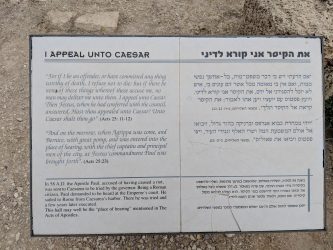
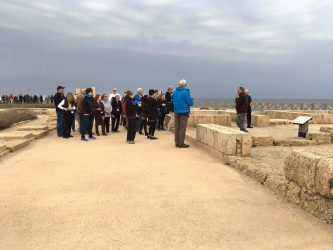
After spending a few hours at Caesarea Maritima we headed to Jerusalem. It was rush hour, but when we approached the city our guide welcomed us to Jerusalem. Jerusalem is at a higher elevation, so when the Bible speaks of going up to Jerusalem it is speaking literally. It struck me as we arrived that I, too, was “going up” to Jerusalem, just as many pilgrims had done for millennia. We would be staying at the Notre Dame of Jerusalem Center, and as I was heading to my room I saw they had a chapel on the first floor and the Blessed Sacrament was on the altar for Adoration. They have Adoration every afternoon for about an hour. I found out that the chapel was Our Lady of Peace, and as I was praying there I though of everywhere the Lord had taken me since I answered his call in 1996: it was after attending Mass at Our Lady, Queen of Peace Shrine in Santa Clara, CA on the feast of the Nativity of Mary that I said yes to the Lord’s invitation to study for the priesthood. Our Lady of Peace in this chapel was smiling down on me again, twenty-three years later, and she had helped me come on pilgrimage to the Holy Land.
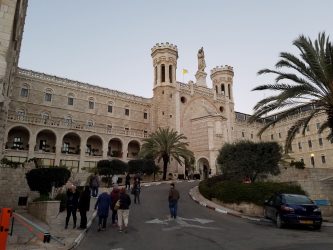
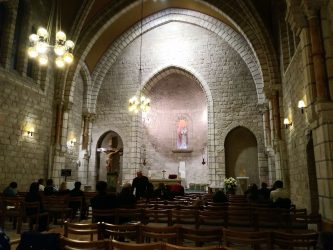
Day 6 (Thu. Feb. 7): Bethlehem, Ain Karem
Our first full day in Jerusalem we headed to Bethlehem, which was under Palestinian control since 1995. After shopping at a gift store owned and operated by Palestinian Christians we headed to the Church of the Nativity, under the authority of the Armenian Orthodox. The entrance to the Church is very low; it was modified in the year 1500 to hinder looters, but now it has a spiritual significance: if you want to enter the place where Jesus was born, you have to bow your head. We lined up and each of us had a moment to kneel before a star indicating an opening in the floor where you could touch a part of the cave in which Jesus was born.
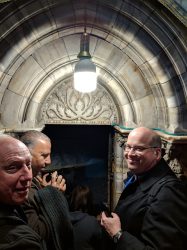
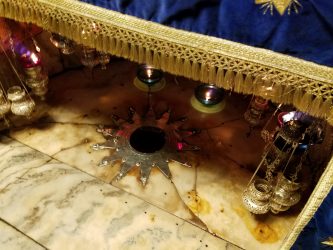
After visiting the spot we went to the nearby Catholic church of St. Catherine of Alexandria for Mass in the chapel of St. Jerome. We celebrated the liturgy for Christmas Day. I asked to preside over this Mass because St. Jerome is the patron saint of Croatia, and the chapel is named after him because St. Jerome lived there for thirty years while translating the Bible into Latin (an edition now known as the Vulgate that replaced the old collection of Latin translations called the Vetus Latina). Croatians are known to have short fuses, and St. Jerome, who was from the Dalmatian coast, was no exception. When he lost his temper he purportedly said “Forgive me Lord, I am Dalmatian.” He also tried to channel that anger into something constructive: learning the ancient languages that would enable him to translate the Bible. Jerome is famous for saying “Ignorance of Scripture is ignorance of Christ” (from the Prologue of his Commentary on Isaiah).
The First Reading, from Isaiah (9:1-6), spoke of the light having dawned. With the Savior’s birth he too has come to light after spending nine months in Mary’s womb. Reading the Gospel (Luke 2:1-14), the story is written like a dawn that leads to daybreak: the moment of birth is quiet and uneventful, then one angel appears to the shepherds, then suddenly there is a blaze of heavenly glory rejoicing over the news. The Lord chose a quiet, poor birth to teach us what really mattered: God and each other. He didn’t need a palace with the finest amenities: he had Mary, Joseph, and his Heavenly Father, and that was all he needed. We’re brothers and sisters in Christ, the family of God that we call communion. The Lord wanted to bring us his peace, a deeper peace that he showed us from the manger.
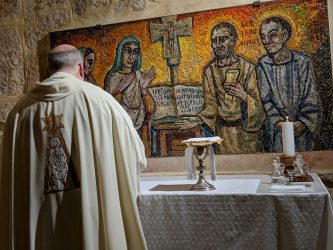
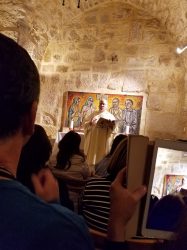
After Mass in the chapel of St. Jerome we went to a spot called the Milk Grotto. As the story goes, the Blessed Mother stopped here to nurse Jesus when the Holy Family was fleeing to Egypt in order to escape Herod’s soldiers and a drop of her milk was spilled here, making the stone white. The spot is now sacred to both Christians and Muslims (Muslims revere Mary because she is the mother of Jesus, whom they consider a prophet). New mothers and women trying to conceive come here and take a little of the soft white chalk to mix into their food, praying to Our Lady of the Milk to either get pregnant or to increase their milk for nursing their baby (or both, I suppose).
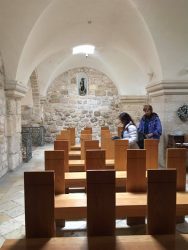
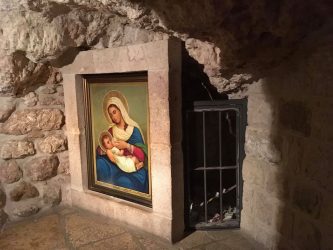
After the Grotto we visited a park that had been a shepherd’s field, possibly the one where the angel appeared to the shepherds, but at least a place to picture the scene. In the park they had a cave with a chapel that is basically laid out like a cave used as a home in Jesus’ time to give us an idea of what the cave in which Jesus was born might have been like. It had sections for living space and for keeping the animals safe at night. We sang Christmas hymns here and just sat back and imagined it all. There is also a church on the property commemorating the angels appearing to the shepherds and singing.
To conclude the day we went to the town of Ain Karem, where Mary hurried right after the Annunciation to help her pregnant cousin Elizabeth (Luke 1:39–40). Zechariah and Elizabeth had two homes: one in a valley and a summer residence that was higher in order to alleviate the heat. On the spot of the lower house is the Church of the Nativity of St. John the Baptist. The walls outside the church have the Benedictus of Zechariah (Luke 1:67–80) written in various languages, the first words John the Baptist’s father said after his encounter with the angel Gabriel (Luke 1:5–25). At the spot commemorating his birth it says hic precursor domini natus est (Here the precursor of the Lord was born).
The Church of the Visitation is a short hike from there. The panorama photo below is looking back toward the Church of the Nativity of St. John the Baptist.
The Church of the Visitation is one of the most beautiful churches I have ever seen, with the Magnificat of Mary (Luke 1:46–56) posted in various languages.
The Italian architect Antonio Barluzzi (1884-1960) designed many of the churches we visited, and his work is breathtaking. He helped construct or restore twenty-four structures in the Holy Land. In the lower church on the site the Visitation (Luke 1:39–55) is depicted, as well as the slaughter of the Holy Innocents (Matthew 2:16–18). A large stone is preserved here that is believed to have miraculously hid Elizabeth and baby John from the soldiers seeking to slaughter John.
An upper church was so beautiful it left me speechless, so I’ll let the photos do the talking.
Day 7 (Fri. Feb. 8): Mt. of Olives & Mt. Zion
The next day we left our lodgings at 5:10 AM to walk through the quiet morning streets of Old Jerusalem over to the Church of the Holy Sepulcher, where we had Mass scheduled for 5:30 AM at the Chapel of Calvary. The Church of the Holy Sepulcher is a complex covering various spots. As we entered we saw the stone on which the Lord, after having been taken down from the cross, was anointed for burial. To the left stairs wind up to Calvary (the overhead shot below is taken from those stairs), the chapel where we’d celebrate Mass.
In the opposite direction from the anointing stone was the sacristy and, on the way, the Holy Sepulcher where Jesus was buried and rose from the dead. In the early hour the sepulcher was closed to visitors, but the morning chants of monks floated through the air as we prepared for Mass. The sacristan told us we had 25 minutes for Mass, no singing, no homily. Being on Calvary said more than I could ever think of anyway, and it was a beautiful Mass.
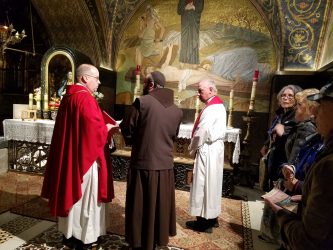

To the left of the Calvary Chapel, separated from us by a wall, was the chapel of the Orthodox with an altar built over the spot where Jesus was crucified. We waited in line to go up to the spot and reverence the place where Our Lord sacrificed himself to free us from our sins. We’d return to the Church later on our pilgrimage to visit the Holy Sepulcher. Every surface was decorated beautifully, a far cry from the desolate carnage that had taken place there on Good Friday, underscoring the sublime nobility of Our Lord dying on a Cross for our sins.
After returning to our lodging for breakfast and mandatory caffeination we headed out and up to the mountain facing the Temple, to the Mount of Olives, separated from the Eastern side of Old Jerusalem by the Kidron Valley. We started near the top, at the small structure built over the spot where Our Lord ascended into Heaven, then started making our way down the mountain to other sites, along the road where the Palm Sunday procession is held each year.
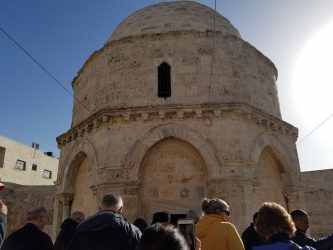
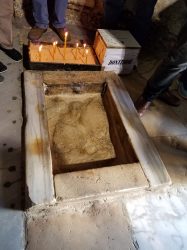
Another Church recalled the spot where the Lord taught the Our Father to his disciples, and the Lord’s Prayer was posted in various languages throughout the complex. A vast Jewish cemetery covers the mountain. The Jews have an interesting custom: as a sign of respect for the dear departed, a visitor leaves a loose stone on top of the tomb. They do this, as I found out, because they hope those stones will be used to construct the Third Temple. The First Temple was the one started by King David and finished by King Solomon, and was destroyed by the Babylonians. The Second Temple was built by Herod the Great and stood in Jesus’ time, then it was destroyed by the Romans in 70 A.D. If you look at the cemetery photo below you’ll see a golden dome in the distance. That’s where the Second Temple stood.
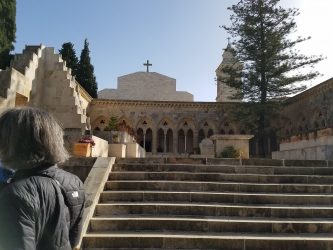
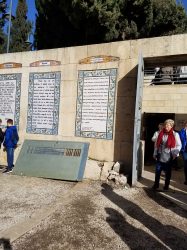
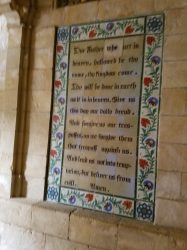

To visit spots on the mountain we sort of zigzagged down, arriving next at the church of Dominus Flevit (Latin for “the Lord wept”), the spot where Jesus looked upon Jerusalem before entering and wept because they had not welcomed him as the Messiah and he knew the city would be destroyed (see Luke 19:41–44). We took our group photo at this spot because a terrace on the property afforded a magnificent view of the Temple area and the wall around Old Jerusalem, a wall built by the Ottomans in the 16th century.
The Kidron Valley is also covered with tombs, and in the center of the Eastern wall is a sealed gate, the Golden Gate (also called the Eastern Gate). For both Jews and Christians this is where the Messiah will make his triumphal return to Jerusalem. In the case of the Christians we believe the Messiah already passed through this gate on Holy Thursday after being betrayed and arrested in Gethsemane. The Muslims also believe a great prophet will come and use the gate in an apocalyptic event. It was closed by the Muslims in 810, reopened in 1102 by the Crusaders, walled up by Saladin after regaining Jerusalem in 1187, then the Ottoman Sultan Suleiman the Magnificent rebuilt it with the city walls and walled it up in 1541. The last photo below is a close-up of the Golden Gate from farther down the mountain.
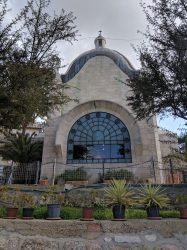
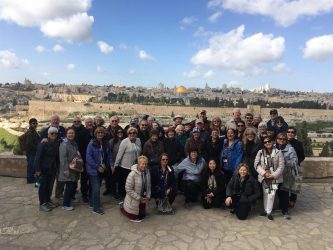
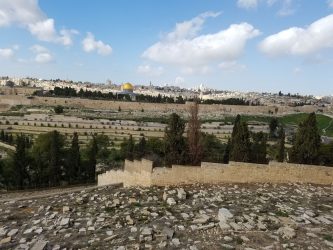
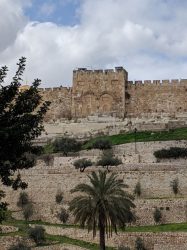
We finished the morning visiting the garden of Gethsemane, where a patch of olive trees is preserved, including a olive tree two thousand years old, probably a witness to Our Lord’s suffering and betrayal here. The Church of All Nations was also built here, which we visited for the first time, planning to return there two days later for Sunday Mass. Before the main altar of this Church is the stone where the Lord knelt and prayed.
As we returned to the bus and headed back to Notre Dame of Jerusalem Center for lunch many Muslims were walking the streets for Friday prayers at the mosques, just as the Jews did in synagogues on Saturday (the Sabbath) and we do on Sundays for Mass.
After lunch we headed to the south of Old Jerusalem, starting at the Upper Room (the Cenacle). It was in this room that Our Lord instituted the Eucharist, the Priesthood, and gave the commandment of love, which we commemorate every Holy Thursday. The Risen Lord appeared to the Apostles for the first time here. It was also where the Holy Spirit came down upon the disciples at Pentecost. As a religious priest this was a special place for me. As a priest, this was where my priesthood was instituted, a priesthood that participates in the priesthood of Christ, the High Priest. As a religious, living as a Legionary of Christ as part of the charism Regnum Christi, it was where the Holy Spirit started giving out gifts in earnest, including the gift of consecrated life. I quietly renewed my priestly promises made at ordination, just as the married pilgrims had renewed their vows at Cana:
-
Do you resolve, with the help of the Holy Spirit, to discharge without fail the office of priesthood in the presbyteral rank, as worthy fellow workers with the Order of Bishops in caring for the Lord’s flock?
-
Do you resolve to exercise the ministry of the word worthily and wisely, preaching the Gospel and teaching the Catholic faith?
-
Do you resolve to celebrate faithfully and reverently, in accord with the Church’s tradition, the mysteries of Christ, especially the sacrifice of the Eucharist and the sacrament of Reconciliation, for the glory of God and the sanctification of the Christian people?
-
Do you resolve to implore with us God’s mercy upon the people entrusted to your care by observing the command to pray without ceasing?
-
Do you resolve to be united more closely every day to Christ the High Priest, who offered himself for us to the Father as a pure sacrifice, and with him to consecrate yourselves to God for the salvation of all? [I do with the help of God]
-
Do you promise respect and obedience to the diocesan Bishop and to your legitimate superior?
It didn’t occur to me to bring a copy of my Legionary vows as well. The Cenacle is an empty, unfurnished room, with a small colonnade in one corner from the time of the Crusaders, with arched ceilings. The Muslims and Jews dispute ownership of the room; for Muslims it is part of a mosque, and for Jews it is part of the complex of King David’s tomb. The Eucharist is said there now infrequently, and only with special permission (such as when the Holy Father wants to say Mass there, as Pope Francis did in 2014). In a niche of the room some pigeons were roosting who had defecated down one of the walls. I was truly moved to be there, but also saddened that such an important spot was not an active church of any Christian denomination as it deserved to be.
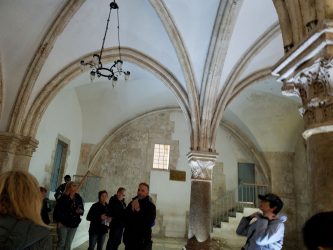
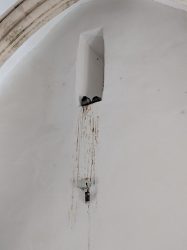
In the same complex we headed below to visit the tomb of King David. There were two entrances, one for men, the other for women. Men had to enter with their heads covered, so those of us who weren’t wearing hats took a little white plastic/polyester kippah (the Hebrew word for the skullcap; in Yiddish it’s called a yarmulke) to cover our heads while we visited. As I prayed quietly in front of the tomb there were also Jews with their prayer shawls and wide-brimmed black hats reading from small prayer books and bowing repeatedly toward the tomb. Outside the doorway leading into the tomb were some pews where Jewish children under an adult’s direction were also saying prayers. The photos here (except for one photo I found on the Internet, bottom right) are from the side for women, since my photos were munched.
We walked over to the Church of the Dormition, where it is believed that Mary was assumed into Heaven (some say it took place in Ephesus). It is called the Church of the Dormition because of a longstanding Eastern Christian tradition that Mary did not experience physical death before her Assumption; she simply fell asleep. When the teaching of the Assumption was formulated as dogma in 1950 it simply affirmed that “having completed the course of her earthly life” she was assumed into heavenly glory, respecting a legitimate difference of Christian opinion regarding the details.
The last stop for the day was St. Peter in Gallicantu, referring to where Peter, having denied Jesus, heard the cock crow (Gallicantu in Latin), just as Our Lord had predicted (see Matthew 26:74-75, Mark 14:72, and Luke 22:60).
This Church is built on the ruins of Caiaphas’ palace, where Jesus was taken for questioning by the High Priest. This panorama shot is the chapel below the main church level.
In this same complex was a dungeon where prisoners would be hung by their wrists or left suspended in a pit. Our Lord probably hung there on Holy Thursday evening before they took him to Pilate. At the spot where he was probably suspended between Heaven and earth (the round hole depicted in two photos below), now a stone chamber with faint red crosses traced on the walls, we read Psalm 88: “For my soul is full of troubles, and my life draws near to Sheol. I am reckoned among those who go down to the Pit;…” (vv. 3-4).
We visited the main church level last, and I asked forgiveness for any infidelity to Our Lord and renewed my desire to care for his flock, just as I had done at the Church of the Primacy of Peter. It was another church by Barluzzi and also beautiful in its design.
Since we’d had a long day we returned early to our lodgings. Being Friday afternoon, our guide explained that the Sabbath would begin for the Jews at 3 PM and would last until nightfall on Saturday. Observant Jews would remain home and do no work, walking to synagogue services. Certain neighborhoods were closed off to traffic by the police, because if an unwitting person drove into them their car would be trashed by outraged Jews (with no guarantee that they wouldn’t get a thrashing too). There was a luxurious shopping mall we passed frequently, and when the Sabbath started, it closed. Some families would gather in hotels instead of their homes to rest and observe the Sabbath.
Back in the Notre Dame of Jerusalem Center I was praying the Sorrowful Mysteries in the chapel and as I was contemplating the Agony in the Garden it dawned on me that I had just been there a few hours ago. It’s hard to put into words what I felt in that moment. When you have actually been there you will never be the same again.
Day 8 (Sat. Feb. 9): Dead Sea Region
On Saturday morning we headed to Bethany, two miles as the crow flies from Jerusalem and under Palestinian authority, but a little farther by bus because the security walls built by the Israelis meant we had to made a long loop to get there. On the outskirts of Bethany signs warned Israel citizens not to enter because their lives would be in danger (a stock photo is below that resembles the sign I saw; I’m not sure if the wording was exactly the same, but it did warn Israeli citizens their lives would be endangered).
In Bethany we visited the Catholic Church of St. Lazarus, built in the area of Lazarus’ tomb, and the ruins of what is believed to have been the house of Mary, Martha, and Lazarus. We celebrated Mass at a chapel in the complex, then after a brief pause for shopping and camel rides (yes, camel rides; no, I did not ride a camel) we headed down to one of the two spots of the Jordan where it is believed Our Lord was baptized by St. John the Baptist.
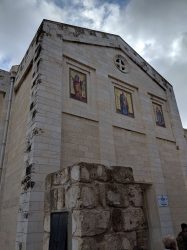
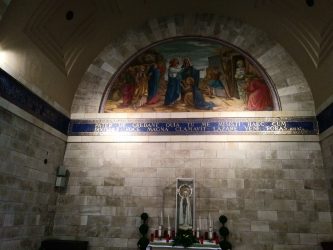
Scripture talks about going down to Jericho, and that is no exaggeration: the Dead Sea region is the lowest point on earth. As we headed down signs along the highway showed how far below sea level we were travelling. Until now we had been travelling through fertile areas, very green despite the climate. Now we were heading into the desert. Bedouins, nomadic Arabs, still set up settlements in patches of desert, using more advanced materials than their ancestors, but still living a nomadic existence. A lot of places along the road had camels in addition to cars, though it wasn’t clear to me whether the camels were just for tourists.
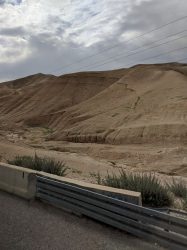
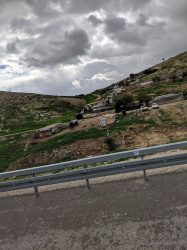
At the Jordan many Christians of various denominations were present, including those going into the waters for baptism. Our guide explained that, for some Christian denominations, coming for another Baptism in the Jordan (which is not the Catholic faith: we believe in one Baptism for the forgiveness of sins) was akin to the forgiveness Catholics receive through Confession. Across the river from us was the country of Jordan and an Orthodox Church. We renewed our baptismal promises, and then headed to the modern town of Jericho for lunch (as opposed to the ruins of old Jericho).
We also stopped at a spot in Jericho purported to be where Zacchaeus climbed the sycamore tree to see Our Lord (Luke 19:1–10), complete with a sycamore tree (and vendors hawking their wares–I stayed on the bus). We also stopped at a good spot to view an Orthodox monastery on the mountain where Our Lord was tempted by the Devil (time constraints and past failed attempts to visit the monastery made us skip it for more time at the Dead Sea).
Our first view of the Dead Sea was from the ruins of the Essene monastery at Qumran. The Essenes were an ascetical Jewish cult preparing for an apocalyptic event. They withdrew from Jerusalem into a monastery where they dedicated themselves to Scripture, ritual purification, and ascesis. The ruins were full of baths and aqueducts for taking water between the pools.
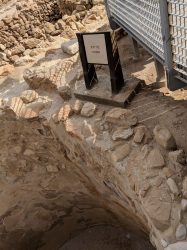
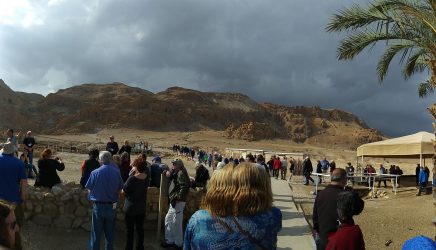
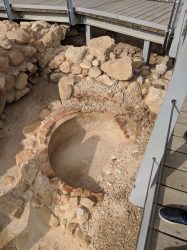
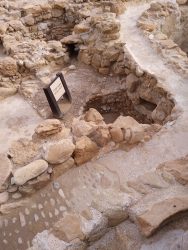
In the caves at Qumran a shepherd in the 1950’s made one of the greatest discoveries in the XX century of Biblical archaeology: the Dead Sea scrolls. In eleven caves at this site approximately 230 Biblical scrolls were found, fragments of text from the Old Testament in Hebrew. Among these scrolls were Biblical manuscripts a thousand years older than any manuscripts previously discovered, and they showed the Masoretic text (the Hebrew text of the Old Testament) was remarkably similar to the later text. The caves also held a lot of manuscripts from the Second Temple period. From this site we could also see Mount Nebo in the distance, the mountain where the Lord took Moses to see the Promised Land before he died (Moses was not allowed to enter the Promised Land, just to see it from afar–see Deuteronomy 34:1–8).
We spent the remainder of the afternoon travelling to the Dead Sea, giving the pilgrims who wished time to swim in the heavily salty waters (or float at least–it is incredibly buoyant due to all the salt it contains; no, I didn’t swim).
Day 9 (Sun. Feb. 10): Old City of Jerusalem
Our last full day in the Holy Land began back at the Church of All Nations at Gethsemane, where we celebrated Sunday Mass at the altar standing behind the stone on which it was believed Our Lord prayed and suffered. The informal title of my homily was “Where the rubber hits the road.” Whenever we celebrate the Eucharist the sacrifice that Christ made on the cross is made sacramentally present to us. Christ’s entire life is salvific: everything he said and did, even his attitude. When we celebrate the Eucharist at Gethsemane we are sacramentally taken back to that moment when he kneeled and prayed on the stone before us that the cup of his suffering be taken away, if possible, but that the Father’s will be done.
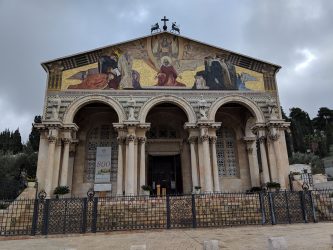
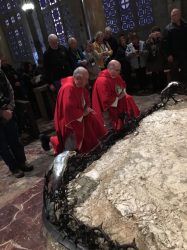
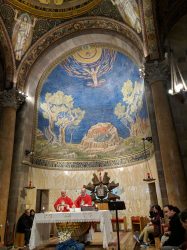
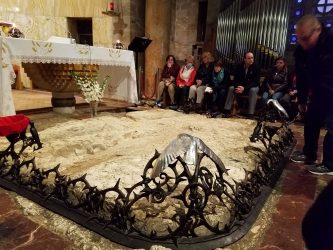
The previous Friday morning we’d celebrated Mass at Calvary, where his sacrifice took place on the Cross, and at Gethsemane we recall the moral suffering of Christ that went along with that physical suffering. Our Lord in creating us in his image and likeness gave us the gift of freedom, the freedom to choose our path, to do good and avoid evil or vice versa. Some people think that means freedom should be total, but lose sight of the fact that with freedom comes responsibility and consequences. Our Lord at Gethsemane is contemplating all the moments where we used our freedom irresponsibly; sin prevents us from growing spiritually and it hinders others from growing as well, separating us from God and from others. Sin has a price and consequences throughout salvation history.
Our Lord assumed a human nature because through that humanity he willed to redeem us, and the moment of Gethsemane reminds us that in his human nature he is trembling at the thought of what he has to undergo to redeem us from our sins. He is contemplating man’s sins throughout history. He is taking the bill for those sins upon himself, and it is a big, big bill. There was no declaring bankruptcy or skipping town. In this moment he in his humanity (since in his divinity the will to redeem us with himself and his Father is steadfast) is testing to see if there is any other way, because he is scared, just like we all get scared when something demanding is asked of us, something that seems beyond our strength.
In one account of the Temptation in the Desert is says the Tempter withdrew to await a more opportune time (see Luke 4:13), and the animated feature The Miracle Maker depicts the Tempter returning at Gethsemane to tempt Our Lord once again. This teaches us that temptation is not sin. Our Lord is like us in all things but sin. It’s okay to take a moment to ask, “Can I really do this?” It is not a sin to be afraid of doing God’s will, just as it was not a sin for him, in his humanity, to be afraid of doing his Father’s will.
The sleeping disciples remind us that, like Our Lord, those difficult moments we face, moments where it is difficult to surrender ourselves to God’s will, are moments of solitude where even those closest to us cannot help us. In the moment of Gethsemane some speculate that Our Lord was contemplating all those who would accept his gift of redemption, a cause for consolation (the Blessed Mother, the Saints, etc.), and all those who would reject it, a cause for sorrow (Hitler, Stalin, all those involved in atheist or totalitarian regimes, those who twist religion into something horrible, like terrorists and “fundamentalists,” unrepentant sinners). Despite this he has a heart that is willing to embrace all those people and pay that bill. He stood up with the decision made and strong in his humanity, and the repeating of “Thy Will Be Done” before he did shows he was gathering that strength in prayer. The big decisions are not made in a snap and done, we must persevere in our commitment. I invited those participating in Mass to contemplate what Gethsemane they were facing in that moment so that they could take it to prayer and gather the strength to surrender to God’s will, unafraid of being afraid as Our Lord was.
After Mass we headed into the old city and walked the Via Dolorosa, a path for the faithful to walk and pray the Way of the Cross. Near the start of our visit we stopped at the Church of St. Ann, believed to have been built on the site of her home. In this site were also the ruins of a Crusader complex over the pools of Bethesda, where Our Lord healed a paralytic who was waiting for a miraculous healing by being placed in the pool (see John 5:1–18).
The church was also built built at the time of the Crusaders (XII century), and below it was the spot where it was believed that Mary was born, commemorated by a small chapel. The spot where Mary was believed to have been born and Gethsemane were the two most powerful places for me of the whole pilgrimage.
On the eve of the Feast of the Birth of Mary, September 7th, 1996 I attended a Mass at Our Lady, Queen of Peace shrine in Santa Clara, CA, celebrated in Latin according to the Extraordinary Form (also known as the Tridentine Mass) with the St. Ann Chapel choir singing polyphony. The shrine was celebrating its twenty-fifth anniversary of perpetual Eucharistic Adoration when practically nobody was doing it. I returned from that Mass excited and that evening I decided to become a priest. So I consider the Feast of the Birth of Mary as the anniversary of accepting my vocation to the priesthood. I was truly overwhelmed down there, and sat for about fifteen minutes in silent, grateful prayer.
The Via Dolorosa starts in the Muslim Quarter (the old city is divided into multiple quarters: Muslim, Jewish, Armenian, and Christian). For the Muslims it was a normal day of work, so the streets were bustling, shops close to one another open and noisy, and when we stopped to pray at a station we had to make sure to leave room alongside us free to let people pass by. All the hustle and bustle of this Way of the Cross made it very tiring and was in great contrast to the short walk we’d made the previous Friday through the Christian Quarter, early in the morning when it was quiet and the city asleep.
The last stations of the Way of the Cross were inside the Church of the Holy Sepulcher, and we finished the Way of the Cross and then got in line to go inside the Holy Sepulcher itself. We were in line about 30-45 minutes, but we were lucky, because at peak times it takes hours to pop into the tiny Sepulcher and pause for just a moment to see the spot where Jesus rose from the dead.
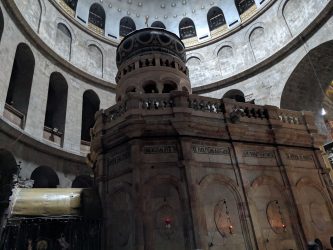
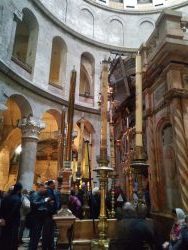
After lunch we made one last official pilgrimage stop: the Western Wall at the Temple Mount. This wall was part of what remained of the Second Temple, and Jews gather here to pray and to tuck written prayers in the nooks and crannies of the Wall. Atop the Temple Mount is the Dome of the Rock, which only Muslims can enter. Security to come to the wall was tight and cameras monitoring everything, since any incidents in this area would spark a lot of trouble. The Orthodox Jews would not want to walk up on the Temple Mount for fear of treading on the ruins of the Holy of Holies.
The Dome of the Rock, with a large golden dome, is the third most sacred site to Islam, and it is on the spot where the First and Second Temple stood (see 2 Chronicles 3:1). It is also believed to be Mount Moriah, where Abraham was going to sacrifice Isaac at the Lord’s command (see Genesis 22:2). The photo below from Wikimedia commons shows the dome seen from the plaza of the Western Wall, the large wall below it in the photo.
As at King David’s tomb men and women visited the Wall by separate lines, and men had to cover their heads. There were numerous fountains with water for doing ritual purification, and also racks of prayer books for the Jews (the book rack photo below is from the women’s side). I went up to the Wall and placed my hand on it as I prayed, and prayed for all people and religions to come to know Christ. I was amazed at how many little prayers were inserted into the Wall everywhere. I spent more time at that Wall than I expected; just as we draw near to Our Lord when he is sacramentally present in churches and chapels throughout the world, there was an extended time where the Lord was present in this Temple in a special way.
That evening we had a farewell dinner at the Eucalyptus Restaurant and the next day was a free day before leaving Israel. I headed out midday and traveled back to Rome via Paris (airport). It was a week and a half I’d never forget.
